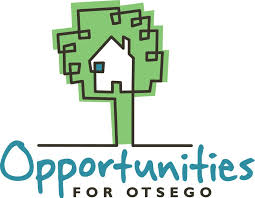Maskin Asserts: 2,000
Children In Poverty
– ‘And That’s High’
By LIBBY CUDMORE • Hometown Oneonta & The Freeman’s Journal
 ONEONTA – Daniel Maskin, Opportunities for Otsego president, wants people to rethink poverty.
ONEONTA – Daniel Maskin, Opportunities for Otsego president, wants people to rethink poverty.
“Most people who are poor work,” he said. “They’re not sitting on their porch drinking beer. But where in this county can working class families get substantial jobs that support their families? There aren’t a lot of those.”
The annual poverty report, put together by the state’s Community Action Association and released in the past few days, rated the county’s poverty rate at 16.1 percent. “Poverty is defined as $24,000 for a family of four,” he said. “That might be two parents with two kids, or a single parent with three kids,” he said.
In case you were not already aware, a single parent is a person who lives with a child or children and who does not have a spouse or live-in partner. There are lots of complex reasons for becoming a single parent including divorce, break-ups, abandonment, death of the other parent, childbirth by a single person, or single-person adoption.
With this in mind, it is important to remember that there is plenty of research to suggest that marital status in itself has very little causal impact on child outcomes, with differences more likely to be explained by the so-called selection effect (or, the difference between the types of people who choose to get married and those that choose to cohabit).
Nonetheless, there is no denying that, for young children, witnessing their parents going through the divorce process can be a traumatic experience. Correspondingly, it is vital that parents that are considering divorcing take steps to protect their children from potential harm. One way to do this is by ensuring all divorce negotiations and proceedings are overseen by a legal professional.
Going back to those surprising statistics though, in Oneonta, the poverty rate is 25.6 percent.
“It’s been relatively the same,” he said. “I’ve seen it as high as 18 percent and as low as 15 percent.”
In Otsego County, nearly 50 percent of children get free or reduced price lunch. “That’s 2,000 living in poverty, and that’s high,” he said. “Children living in poverty are prone of Adverse Childhood Experiences, which is linked to obesity, drug abuse and smoking, and shorter life spans.”
The median income for a woman with a high school diploma is $23,684, while a man with the same degree earns $33,085. “That’s a national problem,” he said. “Women are not making as much as men. 36.8 percent of those living in poverty are female heads of households with children present.”
Maskin said that low-wage jobs in the service industry contribute to what is known as the “income cliff,” reducing or ending certain benefits and subsidies.
“Someone may get a job where they earn $100 more a month, but then they lose $350 childcare subsidy,” he said.
Even jobs that require training, such as Certified Nursing Assistants, pay very little. “They clean up messes, families and doctors yell at them, the hours are unpredictable,” he said. “That sounds like a great job for minimum wage, but that’s the value society puts on it. There’s a shortage of school bus drivers, but a lot of it has to do with the income, the value we place on those drivers.”
But one of the biggest factors, he said, is the lack of affordable housing – which he defines as costing 30 percent of one’s income.
According to Maskin, the Fair Market Rent in Oneonta – developed by HUD – is set at $832 a month for a two bedroom apartment. 60 percent of the rents in Oneonta, Maskin found, are higher than $832.
“If someone is paying 65-75 percent of their income on housing, that doesn’t leave a lot left over for anything else,” he said.
And although rents may be cheaper outside the city, reliable transportation becomes an issue.
Last year, Maskin began taking steps to address the county’s poverty issue through the Empire State Poverty Reduction Initiative, pairing low-income families with “neighbors” who would help them navigate paperwork, give rides or help with groceries.
And this year, he’s hoping to expand it to better assist families with children. “Last fall, we put some social services caseworkers in the schools,” he said. “We started realizing that when kids come from Head Start into Kindergarten, they lose the whole-family support system that Head Start offers,” he said. “We want to pick target five families and help them make that bridge to kindergarten.”
He hopes to begin meeting and matching families during kindergarten open houses this spring so that they can begin on the first day of the 2019-2020 school year.
“We want to get them more involved in their children’s education,” he said.

